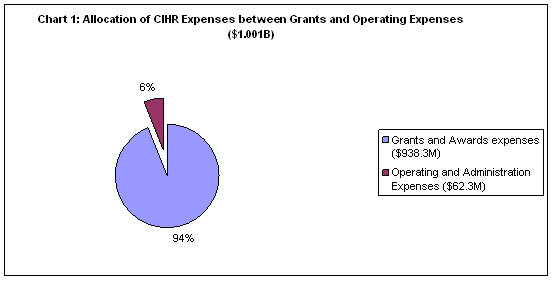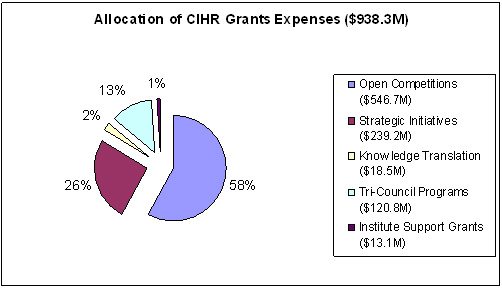Common menu bar links
Breadcrumb Trail
ARCHIVED - Canadian Institutes of Health Research - Report
 This page has been archived.
This page has been archived.
Archived Content
Information identified as archived on the Web is for reference, research or recordkeeping purposes. It has not been altered or updated after the date of archiving. Web pages that are archived on the Web are not subject to the Government of Canada Web Standards. As per the Communications Policy of the Government of Canada, you can request alternate formats on the "Contact Us" page.
Section III – Supplementary Information
Financial Highlights
| Condensed statement of financial position At March 31, 2010 |
% Change | 2010 | 2009 |
|---|---|---|---|
| Assets | |||
| Financial Assets | 1.0% | 16,397 | 16,236 |
| Non-Financial Assets | 9.0% | 4,254 | 3,903 |
| Total ASSEts | 2.5% | 20,651 | 20,139 |
| Liabilities | 7.8% | 26,217 | 24,327 |
| Equity | 32.9% | (5,566) | (4,188) |
| Total LIABILITIES & EQUITY | 2.5% | 20,651 | 20,139 |
| Condensed Statement of Operations At March 31, 2010 |
% Change | 2010 | 2009 |
|---|---|---|---|
| Grants and awards expenses | 1.2% | 938,282 | 927,238 |
| Refund of previous years’ grants and awards | 87.3% | (5,434) | (2,901) |
| Operations and administration expenses | 5.9% | 62,335 | 58,868 |
| Total Expenses | 1.2% | 995,183 | 983,205 |
| Total Revenues | (11.8%) | 9,140 | 10,365 |
| Net Cost of Operations | 1.4% | 986,043 | 972,840 |
Condensed statement of financial position:
Total Assets and Total Liabilities increased by approximately $500K and $1.9M, respectively, compared to 2008-09. The increase in total assets is primarily due to the increase in tangible capital assets, whereas the increase in the total liabilities is mainly affected by an increase to vacation pay and compensatory leave accruals resulting from higher employee salaries.
Condensed Statement of Operations:
Grants and awards expenses increased by $11.0M (or 1.2%) in 2009-10 compared to 2008-09. The primary reason for this increase is CIHR received additional parliamentary authorities in order to spend on programs such as the Canada Graduate Scholarships (CGS) program, the second phase of the Centres of Excellence for Commercialization and Research program, and the Business-Led
Networks Centres of Excellence program. The operating and administrative expenses increased by $3.5M in 2009-10 as a result of higher employee salaries and higher contributions to employee benefit plans.
Financial Highlights Chart
The Financial Highlights Chart above illustrates that CIHR allocates 94% of its available budget directly to fund health research, health researchers and knowledge translation initiatives across Canada. CIHR's primary goals are to fund excellent scientific research, to help fund the next generation of Canadian health researchers to ensure Canada has sufficient health research capacity moving forward, and to focus on key knowledge translation activities to ensure that results of research are transformed into improved policies, practices, products and services, resulting in improved health for all Canadians. CIHR efficiently administers an annual operating budget of approximately 6%, ensuring that 94 cents of every dollar is disbursed directly to fund outstanding Canadian health research and health researchers.

The majority (58%) of CIHR's grants and awards expenses are used to fund Open competitions. CIHR recognizes that the creativity, skill, and insight of individuals and self-assembled teams lie at the heart of the research enterprise. The pursuit of excellence in research, as evaluated through the peer review process, inspires ideas that drive progress and ensures a continuous flow of fresh insights. As such, open competition programs enable individual researchers or groups of investigators to identify research opportunities in any area of health research that peers agree with.
Strategic initiatives comprise the second largest portion of CIHR grants and awards investments (26%). These investments target high priority research areas identified by CIHR's Institutes after broad consultations with stakeholders and partners. These strategic initiatives address emerging health threats and other important health issues of concern to Canadians including areas of health research such as obesity, cancer, vulnerable populations such as youth and aboriginals, pandemic preparedness, HIV/AIDS, or measures to improve the effectiveness of the Canadian health care system.
Knowledge Translation (KT) is a critical and growing part of CIHR's mandate focused on the synthesis, exchange and ethically-sound application of knowledge to accelerate the capture of the benefits of research for Canadians through improved health, more effective services and products and a strengthened health care system. In 2009-10, grants and awards expenses related directly to Knowledge Translation increased by 93% over the prior year to $18.5M.
CIHR incurred 13% ($120.8M) of its 2009-10 grants and awards expenses on various tri-council initiatives – key Government of Canada flagship programs which are jointly administered by CIHR, Natural Sciences and Engineering Research Council (NSERC) and Social Sciences and Humanities Research Council (SSHRC). CIHR incurred expenses totalling $87.2M on the Canada Research Chairs (CRC) Program. The CRC Program awards key research professorships at post-secondary institutions across Canada to attract and retain some of the world's most accomplished and promising individuals. CIHR also spent $29.2M on the Networks of Centres of Excellence (NCE) Program (including the new Business-Led Centres of Excellence program), which brings together partners from the academic, industry, public and non-public centres to conduct leading edge research and knowledge translation activities in areas of strategic growth and opportunity for Canada. CIHR incurred further expenses totalling $4.4M on the Centres of Excellence for Research and Commercialization (CECR) Program. The CECR Program supports the operation of commercialization and/or research centres that bring together people, services, and infrastructure to maximize the benefits of the government's investments in skills and research and to encourage greater private sector investment in science and technology.
CIHR has 13 "virtual" institutes that represent the full spectrum of health science research. Each institute brings together research funders, researchers and research users, including policy-makers and practitioners, to set strategic priorities for research. Each host institution which houses a CIHR institute administers a $1M Institute Support Grant to be used to meet the expenses of housing and running the institutes.
Financial Statements
All of CIHR’s 2009-10 Audited Financial Statements can be found on the CIHR website.
Supplementary Information Tables
All electronic supplementary information tables found in the 2009–10 Departmental Performance Report can be found on the Treasury Board of Canada Secretariat's website
- Sources of Respendable and Non-Respendable Revenue
- Details on Transfer Payment Programs (TPPs)
- Internal Audits and Evaluations
- Green Procurement
7. Source: CIHR Research Reporting System survey, 2009.
8. Source: CIHR career survey of past awardees, 2009.
